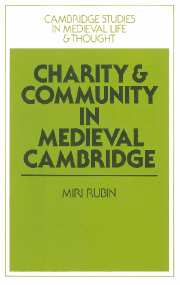Book contents
- Frontmatter
- Contents
- List of tables
- Acknowledgements
- List of abbreviations
- Map
- 1 INTRODUCTION
- 2 THE ECONOMIC BACKGROUND: SUPPLY AND DEMAND FOR CHARITY
- 3 THE IDEA OF CHARITY BETWEEN THE TWELFTH AND FIFTEENTH CENTURIES
- 4 THE CHARITABLE HOUSES OF MEDIEVAL CAMBRIDGE AND ITS SURROUNDINGS
- 5 LIFE IN A MEDIEVAL HOSPITAL: THE HOSPITAL OF ST JOHN, CAMBRIDGE
- 6 THE RELIGIOUS AND ECONOMIC FUNCTIONS OF THE HOSPITAL OF ST JOHN
- 7 CORPORATE AND INDIVIDUAL ACTS OF CHARITY
- 8 EPILOGUE
- Appendix 1 The rule of the hospital of St John the Evangelist, Cambridge
- Appendix 2 The list of masters of the hospital of St John the Evangelist, Cambridge (c. 1207–1507)
- Bibliography
- Index
- Frontmatter
- Contents
- List of tables
- Acknowledgements
- List of abbreviations
- Map
- 1 INTRODUCTION
- 2 THE ECONOMIC BACKGROUND: SUPPLY AND DEMAND FOR CHARITY
- 3 THE IDEA OF CHARITY BETWEEN THE TWELFTH AND FIFTEENTH CENTURIES
- 4 THE CHARITABLE HOUSES OF MEDIEVAL CAMBRIDGE AND ITS SURROUNDINGS
- 5 LIFE IN A MEDIEVAL HOSPITAL: THE HOSPITAL OF ST JOHN, CAMBRIDGE
- 6 THE RELIGIOUS AND ECONOMIC FUNCTIONS OF THE HOSPITAL OF ST JOHN
- 7 CORPORATE AND INDIVIDUAL ACTS OF CHARITY
- 8 EPILOGUE
- Appendix 1 The rule of the hospital of St John the Evangelist, Cambridge
- Appendix 2 The list of masters of the hospital of St John the Evangelist, Cambridge (c. 1207–1507)
- Bibliography
- Index
Summary
That charity was a central preoccupation for medieval men and women is indisputable. In England alone some 220 hospitals were founded in the twelfth century and some 310 in the thirteenth. The donors who endowed and maintained them were granting gifts, allocating property, bestowing food, money, clothes and spiritual care upon strangers, apparently denying themselves some comfort for the sake of others. Some would say that selfless denial is the crux of charity, in that it involves giving with no expectation of reward; and medieval preachers criticised those who ‘sold’ their alms in return for social acclaim. However, gift-giving was also part of the symbolic articulation of social and personal relations, and is at any time an act of self-expression, of the presentation of one's innermost values. Charity cannot be satisfactorily understood as a purely altruistic act since gift-giving is so rich in rewards to the giver. Gifts play an important role in maintaining social cohesion, peace and order; they are major tools for forging friendships and alliances. With most social acts, gift-giving shares the quality of reciprocity and exchange, while, on a personal level, it portrays one's identity. Gift-exchange maintains a society in a constant state of debt, criss-crossed by a network of obligations and expectations of yet unfulfilled reciprocal gestures which bind it closely. Charity as a form of gift-giving is similarly an act rich in meaning.
- Type
- Chapter
- Information
- Charity and Community in Medieval Cambridge , pp. 1 - 13Publisher: Cambridge University PressPrint publication year: 1987



